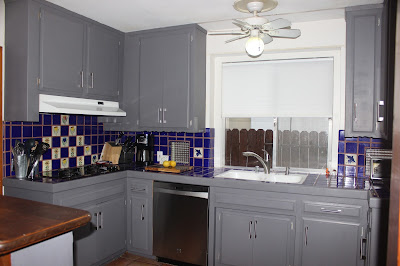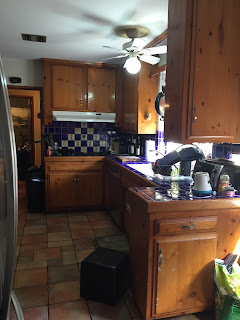Contemporary paint color would only take us so far in modernizing my old ass kitchen. Sleek cabinet hardware would have to seal the deal. After shopping around, I selected the Vinna pulls from Ikea.
Vinna is dah winna!
I did think it was a little strange that they were made up of 3 separate pieces, the bar and the two square pieces. But there was no way that was going to cause unnecessary extra steps and stress, right?
What's that? You're picking up on my sarcasm? Yeah you're right these handles were super annoying and I wouldn't recommend them. But I can only partly blame the Swedes. A large part of the blame falls on me for ever trying. And the rest, the biggest chunk of blame, falls on the carpenter (may he rest in peace?) who built these irregular cabinets with weirdly puffy faces.
The screws that came with the handle were too short to attach the bar. They would probably fit nicely through the width of any normal cabinet door. But not these gems. They left barely enough room to screw on the bar.
So I went out to the store to buy longer screws. The next size up, from 2 inches, was 2 1/2. Surely that would do the trick. I bought a box, tried them out and wouldn't ya know it, these ones were too long.
Back at the store, I picked up washers to fill the gap. It took 6 to make it work, and it looks pretty stupid, but at least it's on the inside. And we're all a little bit stupid on the inside.
After getting though about half the cabinets this way, I ran out of supplies and turned to the all powerful internet to take another stab at finding the best length machine screw. Like a DIY Goldilocks I was able to finally find one that was just right -- 2 1/4 inch -- by special ordering it from an industrial supply source. Who could've predicted the lengths I'd go to for the right length screw?
It was worth it, though, and they fit perfectly. I should probably go back and replace all of the screws on all of the handles, but I'm not sure I should tempt fate because it was a miracle some of them ever stayed on in the first place. Measuring and drilling two holes seemed easy enough, but no matter how meticulously I went about it, I'd still find myself with holes that were too close together or far apart. Finally I got smart about it and made a drilling guide.
Read on for actual useful information:
I used a scrap piece of wood and carefully measured and drilled where the holes needed to be for the handle.
Then, to double check, I lined it up and screwed on the handle. It fit perfectly.
Then, I decided how far up on the doors I wanted the handles to be, and on the reverse side of my board, I drilled in a screw to use as a stopper.
So when the guide is lined up on the face of the door, the stopper catches on the edge of that beveled detail and holds the board in place, for the most part, while drilling into the guide holes.
It definitely reduced the amount of time I spent making and fixing mistakes.
Here's a peek at some painted, handled cabinets. Proper "big reveal" pictures to come, when I have the opportunity to take them. (Besides needing to do some more work, I also need to have a clean kitchen. Impossible.)
Meanwhile, on the west side of the kitchen, I worked on the breakfast bar. It started with sanding to get rid of the pealing, sticky varnish.
When I stay sticky, I mean it was constantly tacky to the touch no matter how much I tried to clean it. See that white stuff? That is where junk mail would adhere to it when left there for too long. It was strange and gross.
It took a lot of sanding to get down to the bare wood, which turned out to be rather lovely.
Then, I applied the same stain I've used on the other wood work in the ModLodge.
Then, three coats of semi gloss polyurethane, sanding with 320 grit paper between each coat.
The result is a counter top that is soft and luxurious and I find myself running my hand over it multiple times a day for no reason.
And, here's a look at the before and after of this bar top / pantry area, with the mod lodge in the background.
Progress! And nicer, full kitchen pictures to come.
But first, a question.
Do you like the blue tile? I know it's hard to see under all the clutter. See what I mean about never having a clean enough kitchen?
I never minded the color, but it wasn't part of my grand vision. However, now that the cabinets are gray, it kind of works and could maybe even pass for intentional. Thoughts?
The alternative would be my original plan to paint them all white, which I still think would look good. But I'm worried about the durability of painted tile. Will it stain every time I spill coffee or marinara sauce (which happens daily)? I also realized that painted tile is never going to look like Caesarstone or Carrara marble. It's only ever going to look like painted tile. Just like painted old cabinets are only old cabinets that have been painted. You know?
The alternative to the alternative would be a compromise, in which I only paint the worst tiles, which are these not-at-all-cool-no-matter-how-you-look-at-them flower tiles behind the stove top. I'd probably go with a metallic silver, something to match the stainless steal. (Apologies for the poorly lit picture. It is really hard to get good lighting in these kitchen pictures.)
So what do you think? Tell me in the comments. The compromise is the best way to go, right? Or forge ahead painting everything white? Or does someone actually think I should keep the flower tiles? And if that's your opinion, please also tell me how many drinks you've had today, or how many grandkids you have, or why you're messing with me and what I ever did to you to deserve it or how you got the impression I have time for your shenanigans.










































